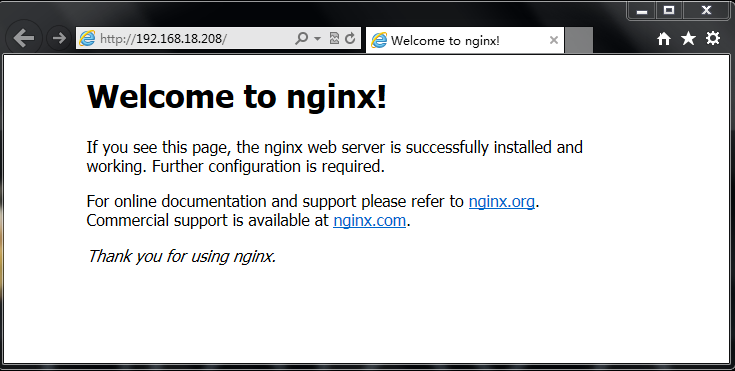Nginxのインストールと設定方法
- PHPz転載
- 2023-05-20 08:43:181191ブラウズ
环境准备
1. 操作系统
centos 6.4 x86_64
2.软件版本
nginx 1.4.2
3.实验拓扑
4.安装yum源
[root@nginx ~]# rpm -ivh http://download.fedoraproject.org/pub/epel/6/x86_64/epel-release-6-8.noarch.rpm [root@web1 ~]# rpm -ivh http://download.fedoraproject.org/pub/epel/6/x86_64/epel-release-6-8.noarch.rpm [root@web2 ~]# rpm -ivh http://download.fedoraproject.org/pub/epel/6/x86_64/epel-release-6-8.noarch.rpm
5.各节点时间同步
[root@nginx ~]# ntpdate 202.120.2.101 [root@web1 ~]# ntpdate 202.120.2.101 [root@web2 ~]# ntpdate 202.120.2.101
6.关闭防火墙与selinux
[root@nginx ~]# service iptables stop [root@nginx ~]# chkconfig iptables off [root@nginx ~]# getenforce disabled [root@web1 ~]# service iptables stop [root@web1 ~]# chkconfig iptables off [root@web1 ~]# getenforce disabled [root@web2 ~]# service iptables stop [root@web2 ~]# chkconfig iptables off [root@web2 ~]# getenforce disabled
安装nginx
1.解压
[root@nginx src]# tar xf nginx-1.4.2.tar.gz
2.新建nginx用户与组
[root@nginx src]# groupadd -g 108 -r nginx [root@nginx src]# useradd -u 108 -r -g 108 nginx [root@nginx src]# id nginx uid=108(nginx) gid=108(nginx) 组=108(nginx)
3.准备编译配置文件
[root@nginx src]# yum install -y pcre-devel openssl-devel [root@nginx nginx-1.4.2]# ./configure --prefix=/usr --sbin-path=/usr/sbin/nginx --conf-path=/etc/nginx/nginx.conf --error-log-path=/var/log/nginx/error.log --http-log-path=/var/log/nginx/access.log --pid-path=/var/run/nginx/nginx.pid --lock-path=/var/lock/nginx.lock --user=nginx --group=nginx --with-http_ssl_module --with-http_flv_module --with-http_stub_status_module --with-http_gzip_static_module --http-client-body-temp-path=/var/tmp/nginx/client/ --http-proxy-temp-path=/var/tmp/nginx/proxy/ --http-fastcgi-temp-path=/var/tmp/nginx/fcgi/ --http-uwsgi-temp-path=/var/tmp/nginx/uwsgi --http-scgi-temp-path=/var/tmp/nginx/scgi --with-pcre
4.编译并安装
[root@nginx nginx-1.4.2]# make && make install
5.为nginx提供sysv init脚本
[root@nginx ~]# cat /etc/init.d/nginx
#!/bin/sh
#
# nginx - this script starts and stops the nginx daemon
#
# chkconfig: - 85 15
# description: nginx is an http(s) server, http(s) reverse \
# proxy and imap/pop3 proxy server
# processname: nginx
# config: /etc/nginx/nginx.conf
# config: /etc/sysconfig/nginx
# pidfile: /var/run/nginx.pid
# source function library.
. /etc/rc.d/init.d/functions
# source networking configuration.
. /etc/sysconfig/network
# check that networking is up.
[ "$networking" = "no" ] && exit 0
nginx="/usr/sbin/nginx"
prog=$(basename $nginx)
nginx_conf_file="/etc/nginx/nginx.conf"
[ -f /etc/sysconfig/nginx ] && . /etc/sysconfig/nginx
lockfile=/var/lock/subsys/nginx
make_dirs() {
# make required directories
user=`nginx -v 2>&1 | grep "configure arguments:" | sed 's/[^*]*--user=\([^ ]*\).*/\1/g' -`
options=`$nginx -v 2>&1 | grep 'configure arguments:'`
for opt in $options; do
if [ `echo $opt | grep '.*-temp-path'` ]; then
value=`echo $opt | cut -d "=" -f 2`
if [ ! -d "$value" ]; then
# echo "creating" $value
mkdir -p $value && chown -r $user $value
fi
fi
done
}
start() {
[ -x $nginx ] || exit 5
[ -f $nginx_conf_file ] || exit 6
make_dirs
echo -n $"starting $prog: "
daemon $nginx -c $nginx_conf_file
retval=$?
echo
[ $retval -eq 0 ] && touch $lockfile
return $retval
}
stop() {
echo -n $"stopping $prog: "
killproc $prog -quit
retval=$?
echo
[ $retval -eq 0 ] && rm -f $lockfile
return $retval
}
restart() {
configtest || return $?
stop
sleep 1
start
}
reload() {
configtest || return $?
echo -n $"reloading $prog: "
killproc $nginx -hup
retval=$?
echo
}
force_reload() {
restart
}
configtest() {
$nginx -t -c $nginx_conf_file
}
rh_status() {
status $prog
}
rh_status_q() {
rh_status >/dev/null 2>&1
}
case "$1" in
start)
rh_status_q && exit 0
$1
;;
stop)
rh_status_q || exit 0
$1
;;
restart|configtest)
$1
;;
reload)
rh_status_q || exit 7
$1
;;
force-reload)
force_reload
;;
status)
rh_status
;;
condrestart|try-restart)
rh_status_q || exit 0
;;
*)
echo $"usage: $0 {start|stop|status|restart|condrestart|try-restart|reload|force-reload|configtest}"
exit 2
esac6.为此脚本赋予执行权限
[root@nginx ~]# chmod +x /etc/init.d/nginx
7.添加至服务管理列表,并让其开机自动启动
[root@nginx ~]# chkconfig --add nginx [root@nginx ~]# chkconfig nginx on [root@nginx ~]# chkconfig nginx --list nginx 0:关闭 1:关闭 2:启用 3:启用 4:启用 5:启用 6:关闭
8.启动nginx
[root@nginx ~]# service nginx start 正在启动 nginx: [确定]
9.查看一下端口
[root@nginx ~]# netstat -ntlp | grep :80 tcp 0 0 0.0.0.0:80 0.0.0.0:* listen 3889/nginx
10.测试一下

以上がNginxのインストールと設定方法の詳細内容です。詳細については、PHP 中国語 Web サイトの他の関連記事を参照してください。
声明:
この記事はyisu.comで複製されています。侵害がある場合は、admin@php.cn までご連絡ください。

